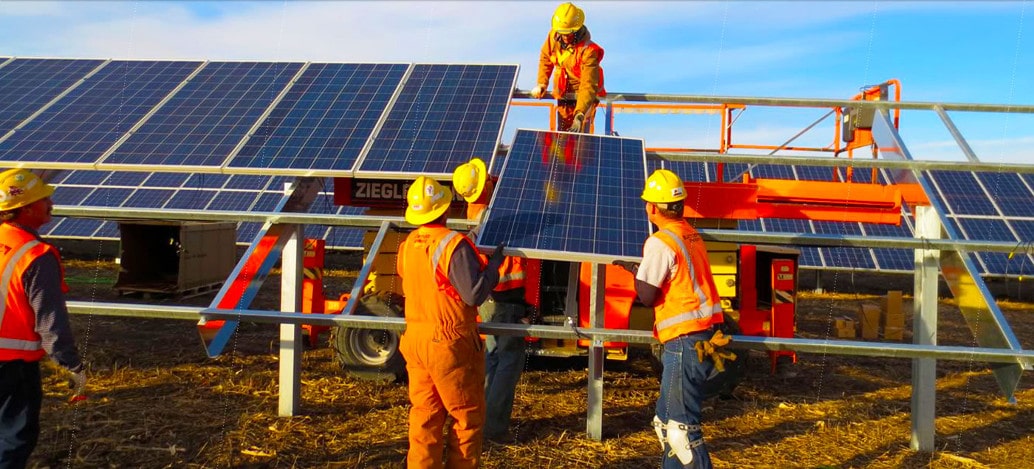This Hispanic Heritage Month, as in previous years, we celebrate the contributions and influence of Hispanic Americans to America’s history, culture, and economy. This unprecedented year, our celebration evolves as COVID-19 has shown us the value of essential services and critical infrastructure. As one of the fastest growing American communities, and an often unrecognized (but critical) part of our workforce, the future design of American energy needs to include Hispanic communities. Improving access to the benefits of solar energy is an obvious win for sustainability and equality.
Economic barriers stand in the way of solar energy access
Rooftop solar provides cost saving opportunities on energy bills, allowing low- to moderate-income (LMI) households to direct those savings towards other essential expenses including healthcare, food, and education. Addressing economic barriers to accessing solar energy is especially relevant today, when COVID-19 related wage loss has increased the proportion of LMI households that are not able to fully cover monthly bills (including utility bills) from 43% to 52%, according to a study by the Pew Research Center. COVID-19 has hit Latinos especially hard.
The U.S. Hispanic population has a higher proportion of LMI households when compared to other groups, with a median income around 82% of the average median income of the United States. Meanwhile, the different avenues through which households can access solar energy often come with cost-exclusive hurdles— high upfront and maintenance costs, credit requirements, and home ownership are often significant obstacles for LMI households. The steep price of a solar system has made solar energy available primarily to upper income households, even though LMI households, which pay a disproportionately higher percentage of their income to energy costs, stand to gain the most from the financial savings associated with having a solar system.
An alternative solar access option, community solar, provides a solution to the home ownership barrier, but still offers its own challenges. Expensive enrollment and subscription fees and credit requirements often prevent LMI households from participating in these programs.
Societal barriers are a factor too
A 2019 study found that Hispanic majority census tracts have installed 30% less rooftop solar than non-Hispanic majority census tracts. The same study also refers to a lack of “seeding,” the effect in which one household in a neighborhood installs rooftop solar then makes it more likely that others in the same neighborhood will do the same. Seeding is a powerful driver for solar adoption. Lack of seeding may also be related to the lack of Latinx and other minority group representation in managerial positions at solar companies.
Many members of Hispanic communities may also face barriers that do not allow them to access educational resources and opportunities that could help in the adoption of solar energy, particularly in light of potential language barriers. Approximately 30% of Hispanics in the United States are not English proficient. Meanwhile, very few residential solar installers have Spanish-speaking resources, which makes it hard for Hispanic community members to learn about the options are available to them.
What can we do as an industry?
The U.S. solar industry should take deliberate, sustained action to overcome these barriers in order to ensure equitable clean energy access for Hispanic communities and grow the solar footprint at the same time. Equally important are efforts to diversify the solar workforce to include more Hispanic professionals, which also serves as an important step in building inroads into Hispanic communities.
Actions companies can take today include:
- Ensure you have a dedicated team internally focused on justice, equity, diversity, and inclusion (JEDI). Establishing a JEDI team serves to institutionalize accountability at the organizational level around promoting these values in company culture, sales, and hiring practices.
- Think about how you can contribute to building and investing in a more inclusive industry talent pipeline that promotes equal access to solar energy education and opportunities. Partner with programs such as the Urban Alliance, the Boys and Girls Club of America, or public schools and universities in your community.
- Develop Spanish sales materials and customer resources and hire Spanishspeaking employees for customer-facing roles. Adding Spanish-speaking employees to your team will break down customer language barriers when working with customers and offer other number of benefits. For example, the Sol Systems SREC aggregation team created a Spanish version of its SREC help center.
- Innovate new ways to serve Hispanics and other minority communities. Check out organizations and programs such as NYSERDA: Solar for All Program, Coop Power, Posi-Gen, and Vote Solar.
Beyond equity, solar companies can expand our market by taking time to identify and act on ways to help reduce the barriers to solar access for Hispanic communities — not just during Hispanic Heritage Month, but throughout the year. Understanding the unique mix of cultural and economic resource barriers that many members of Hispanic communities face is the first step in creating more inclusively designed renewable energy companies. Solar is for everyone. Let’s make sure that rings true throughout America.
***
Javier Chacon works as a Customer Analyst on the SREC Operations team at Sol Systems, where he works closely with customers to help mint their SRECs.
The views and opinions expressed in this article are the author’s own, and do not necessarily reflect those held by pv magazine.
This content is protected by copyright and may not be reused. If you want to cooperate with us and would like to reuse some of our content, please contact: editors@pv-magazine.com.








Thanks for sharing this. Nexamp’s community solar program (full disclosure – I am an employee) and some others have dropped credit check requirements and do not require any enrollment fees or charge any cancellation fees. These changes are making community solar a more viable option for LMI households.